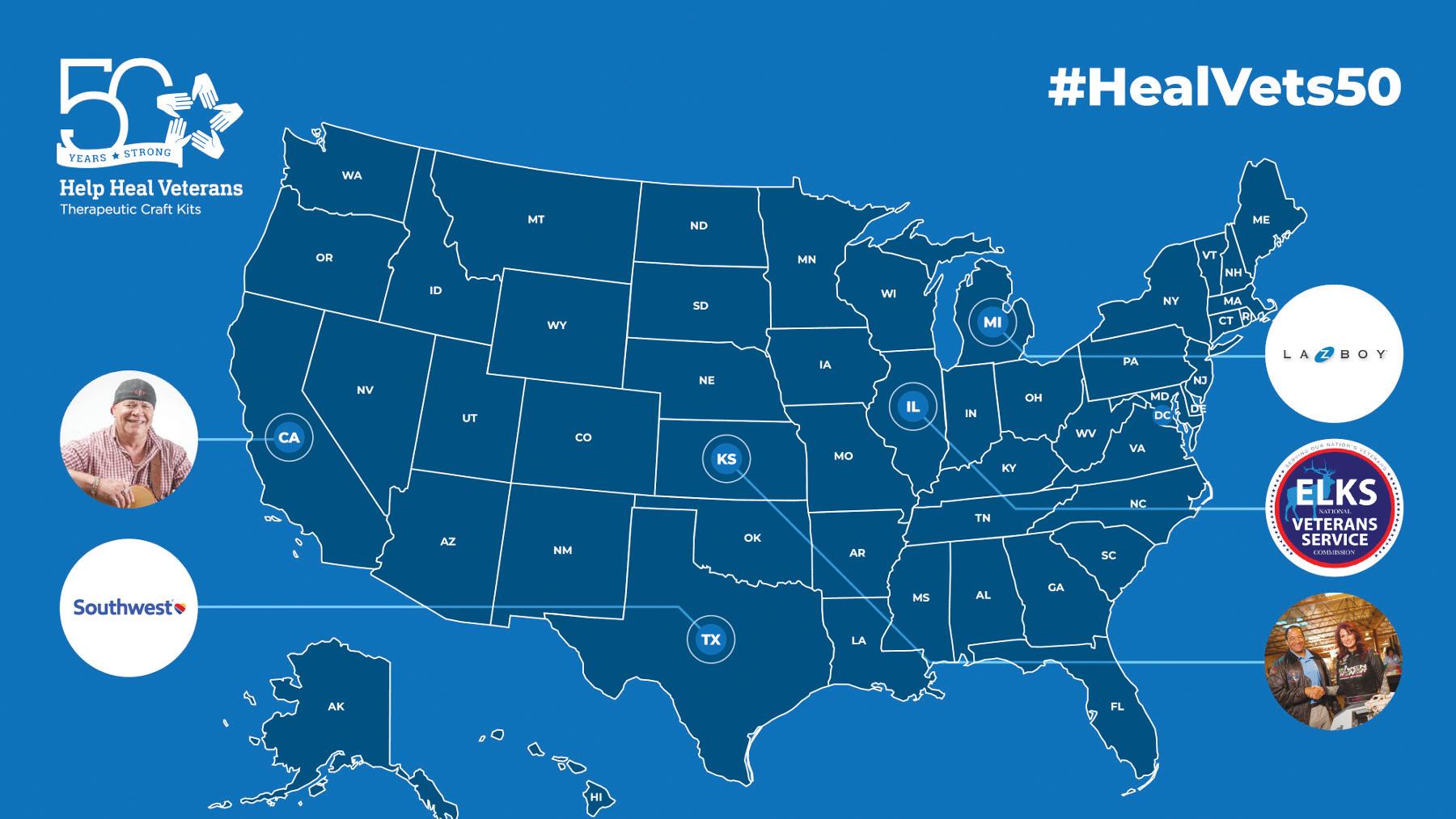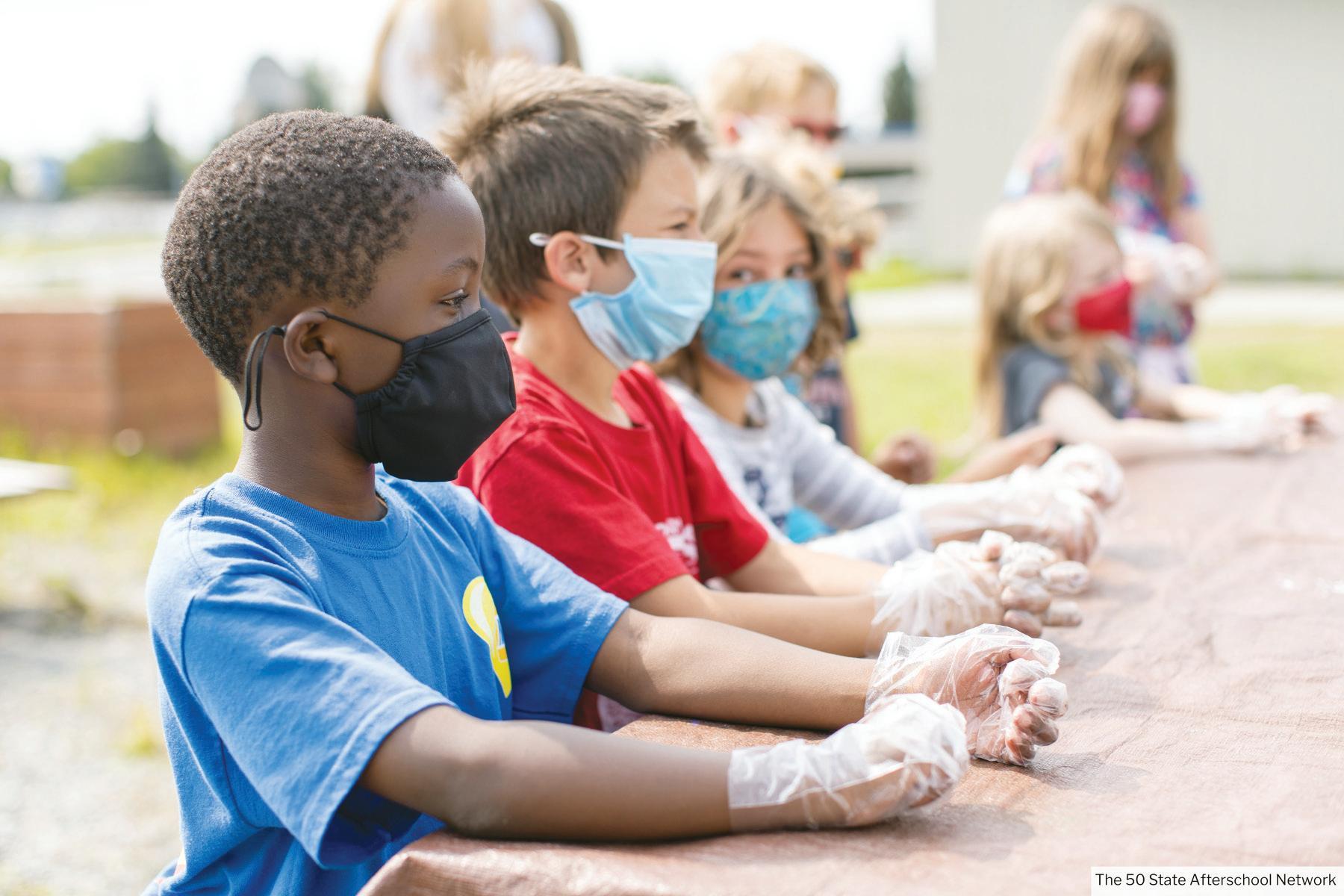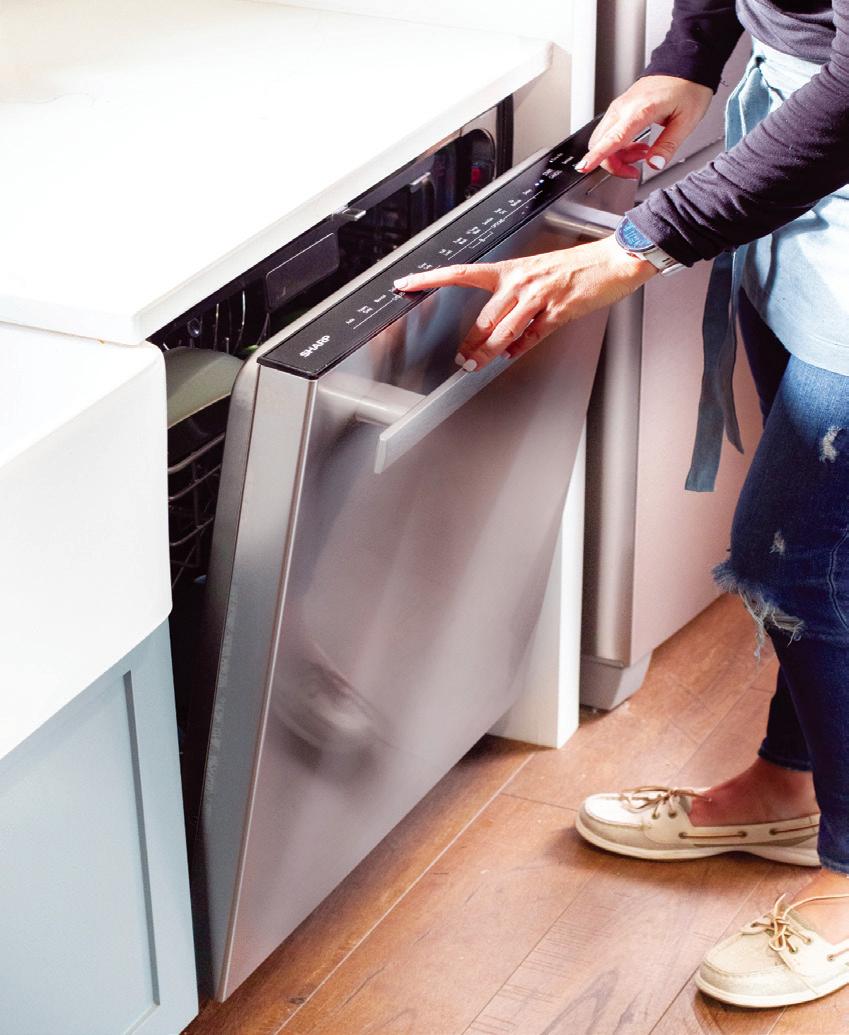
9 minute read
Hearing The Stories Undiagnosed Diabetes?13
12 Austin South Asian | December 2021 Hearing The Stories Of Veterans And Advocates Nationwide
The years after military service can be fraught, as many veterans are dealing with both physical and invisible wounds of war.
A new campaign hopes to draw attention both to the struggles those who have served in the military face and the ways veterans have overcome adversity.
The “50-50-50” campaign -- kicking off on Veterans Day 2021 -- celebrates the 50th anniversary of Help Heal Veterans (Heal Vets) by bringing together 50 stories from the past 50 years -- one from each state.
Heal Vets is a nonprofit organization that has donated tens of millions therapeutic arts-and-crafts kits to veterans and active-duty military.
These craft kits help injured and recuperating veterans improve fine motor skills and cognitive functioning, manage stress and substance abuse, and cope with symptoms of post-traumatic stress disorder and traumatic brain injury,
Afterschool programs keep kids safe, inspire them to learn, and give working parents the peace of mind that comes with knowing their children are safe and supervised after the school days ends and until they return from their jobs.
During the pandemic, the role of afterschool programs grew, with expanded hours and additional services, including delivery of meals and enrichment kits, support for students learning remotely, connecting families to social services, and much more.
Research shows that these programs, which add value and meaning to children’s afternoons, need more funding.
The most recent America After 3PM household survey of more than 31,000 families, commissioned by the Afterschool Alliance, finds that for every child in an afterschool program in the United Heal Vets has shipped more than 690,000 free craft kits since the beginning of the pandemic.
all while also improving their sense of self-esteem and overall physical and mental health.
Among the 50 stories featured in the campaign are: Hobby Teacher program, ultimately ensuring that thousands of veterans would have the opportunity for quality involvement in the creative arts.
• New Jersey: In 1998, Heal Vets partnered with the Hobby Industry Association (HIA) and the Association of Crafts & Creative Industries.
During this time, Heal Vets enrolled sixteen Craft Care Specialists in HIA’s Certified Craft & • Texas: Since 2018, Southwest Airlines and Arise Veteran Foundation have donated more than 300,000 pounds of leather upcycled from airplane seat covers to Heal Vets, helping to make well over 100,000 craft kits.
• California: In 2018, Mark Kaleimamahu, 62, moved into the Alpha Lofts, a housing facility in San Diego for veterans who have experienced homelessness.
A little more than a year later, COVID-19 cases began sweeping the country, creating another longterm stressful situation.
To cope with stress and anxiety during the pandemic, the Marine Corps veteran turned to what some may consider an unlikely source of comfort: crafting kits.
• Washington D.C.: In July of 2020, Heal Vets launched a pilot program in partnership with the Department of Veterans Affairs Voluntary Service that provided “Quarantine Kits” to veterans diagnosed with COVID-19 who were recovering in isolation at home.
Each kit included VA educational materials that identified local resources and provided tools to help deal with anxiety and stress in addition to leisure reading materials and a variety of craft kits. To learn more about Heal Vets and the organization’s efforts, and to find out how you can help, visit HealVets.org.
To read more stories from the “5050-50” campaign that show the power of craft-related therapy, visit HealVets50.org.
If you would like to help support Help Heal Veterans visit https:// support.healvets.org.
“We’ve supported generations of veterans, from the remaining World War II and Korean War vets who are still with us to the Vietnam generation who suffered in silence for many years.
As our latest generation of warfighters returns home from 20 years of conflict in Iraq and Afghanistan, supporting their healing is a priority,” says Joe McClain, USN (retired) CEO, Help Heal Veterans. (StatePoint)
States, three more are waiting to get in.
The families of 24.6 million chil-
dren -- more than ever before -- are unable to access a program, with many reporting cost as a barrier. nificant inequities, with Black and Latinx children more likely to be unable to access the afterschool programs their parents want for

them.
To highlight both the ways afterschool programs support children and families, and the need for additional funding, the Afterschool Alliance recently hosted the 22nd annual “Lights On Afterschool,” a nationwide rally for afterschool programs.
From student performances to TikTok challenges to designing lightbulbs powered by potatoes, afterschool programs around the country hosted a range of creative events and activities focused on academics, social and emotional well-being, arts and music, civic engagement, STEM learning, fitness and healthy eating, bullying prevention, and more. To learn more about the rally, visit afterschoolalliance.org
“We’re sending the message that there aren’t nearly enough afterschool programs to serve all the students and families who need them.
The American Rescue Plan is providing an important but temporary boost for these programs, but the recovery and the growth we need will take more time and resources,” says Jodi Grant, executive director of the Afterschool Alliance. (StatePoint)
To Advertise In ASA Call 512-828-6709
13 Austin South Asian | December 2021 Do You Have Undiagnosed Diabetes?
Diabetes is a chronic condition that leads to serious life-threatening complications, however many people go undiagnosed and are undertreated -- a situation being further exposed by the COVID-19 pandemic. November is Diabetes Awareness Month, and a good opportunity to better understand risk factors, symptoms and the importance of early diagnosis and action.
More than 34 million people in the United States are affected by diabetes, and one-in-five of them are undiagnosed, according to estimates from Centers for Disease Control and Prevention.
Health services organization Cigna reports that between January 2020 and June of 2021, nearly 800 of its patients who were diagnosed with COVID-19 were found to have undiagnosed diabetes. Only 14% of those people had previously been diagnosed with pre-diabetes. had a higher risk of undiagnosed diabetes and COVID-19, which

So why are so many people living with diabetes going undiagnosed? Cigna claims data shows that those at higher risk of having social or economic obstacles to health, also can compound problems.
“As is the case with many medical conditions, timely diagnosis and treatment of diabetes is impacted by persisting health inequities that affect certain communities and populations,” says Dr. Mandeep Brar, Cigna medical director and board certified endocrinologist. “Factors such as race, ethnicity, access to healthful food, education, health care coverage and language barriers, to name a few, all contribute to undiagnosed cases of diabetes.”
However, according to Dr. Brar, early diagnosis is critical for everyone: “When diabetes is left untreated, it will progress, causing complications such as neuropathy, kidney disease, diabetic ulcers and wounds, amputations and other serious and life-threatening issues.
If you’re living with diabetes, the sooner you’re aware of that, the more quickly you can learn to manage your condition and prevent it
Is It Time For A New Dishwasher? 5 Questions To Ask Yourself
There’s no reason to be working harder in the kitchen than you need to be, especially when it comes to clean-up.
“When considering a new dishwasher, it’s important to understand that many dishwashers are created equal, but are not priced equal. Most major brands offer similar features at varying prices.
Sharp dishwashers are designed to offer high-end features at an excellent value,” says Peter Weedfald, senior vice president of Sales & Marketing, Sharp Home Electronics Company of America.
So, how do you know when it’s time for an upgrade in your kitchen? Weedfald shares five questions to ask yourself:
1. What’s my dishwasher’s cleaning and drying power? While earlier dishwashers often required you to do quite a bit of soaking and rinsing before loading the machine, some of today’s models feature soil sensors that automatically optimize your washing cycles. near special sprayers that deliver extra scrubbing power can also be a huge time- and labor-saver. Some classic, elegant luxuries both inside and outside its dishwashers at an affordable price point compared to other brands offering similar features.
Inside its dishwashers are smooth glide rails that make loading and unloading a breeze, as well as premium, white LED lights offering good visibility.
Outside is an easyto-clean stainlesssteel finish that nicely complements other kitchen appliances and fixtures. Plus, a hidden control panel makes for a sleek design that minimizes distrac-

new models have also made handdrying a thing of the past, thanks to heated drying, which is faster and more dependable than condensation drying.
2. Does my dishwasher offer premium features and design at a reasonable price point? Sharp is a good example of a manufacturer offering tions.
3. Does my dishwasher offer flexibility? For an efficiently run kitchen, flexibility is key. To that end, you shouldn’t have to wait until you have a full load’s worth of dishes to run your machine. load option, as well as adjustable racks to accommodate large casserole dishes, tall stemware, and oddly sized items.
4. Is my dishwasher energy efficient? If either sustainability or saving money on utilities are priorities for you, be sure to look for ENERGY STAR rated dishwashers with features such as a halfload option that reduces water and energy consumption when washing smaller loads.
5. Is my dishwasher quiet? To put things in perspective, any dishwasher is going to produce some level of noise. Anything below 52 dBA is considered very quiet. The difference between a 40dBA and 45dBA model will be minimal, so be careful you are not overpaying for this feature.
For more information and resources, visit shop.sharpusa.com.
Thanks to new innovations, dishwashing isn’t what it used to be. For less mess, stress, and hassle, consider upgrading your dishwasher for a better experience. (StatePoint) from advancing.”
According to Cigna, here are three steps everyone can take today:
1. Understand signs and symptoms. Sharing any new symptoms with your primary care provider can be crucial in early detection and proper, timely treatment. Symptoms can include frequent urination, excessive thirst or hunger, unexpected weight loss, cuts or bruises that are slow to heal, frequent infections, very dry skin, extreme fatigue, and blurry vision, according to Dr. Brar.
2. Get screened. Schedule an annual preventive check-up or diabetes screening. Regardless of symptoms, one of the most powerful ways to detect diabetes is to be screened for this disease with a simple blood test by your primary care provider.
If diagnosed with prediabetes, there are a number of lifestyle changes you can make to reverse prediabetes and prevent or delay Type 2 diabetes and other serious health problems. These changes include eating healthfully, increasing physical activity, losing weight and managing stress.
3. Assess risk factors. Some people are more likely to develop diabetes than others. In addition to being 45 years or older, risk factors include being overweight, having a parent or sibling with Type 2 diabetes and being physically active fewer than three times a week.
Additionally, African Americans, Hispanics, Native Americans, Asian Americans and Pacific Islanders are at higher risk than white people for developing Type 2 diabetes. If you have any of these risk factors, request a screening test with your primary care provider, regardless of your age.
For a quick, online Type 2 diabetes risk test, visit diabetes.org/risk-test.
This Diabetes Awareness Month, get savvy about the disease. Understanding symptoms and risk factors can mean early detection and better outcomes. (StatePoint)









